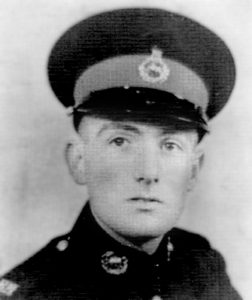In June 1944 I was a 17-year old Royal Marine, serving in Y turret of the light cruiser HMS Diadem. My job was to lift the cordite charge from the magazine hoist and onto a tray behind the high explosive shell. From there both charge and shell were thrust into the barrel.
At 0552 on D-Day HMS Diadem’s guns opened fire on the German Moulineaux battery south of Beny-sur-Mer on JUNO Beach. It was the beginning of many gruelling days for a teenage Marine like me. There was no time to think as I performed my mechanical task. Next cordite charge in hoist … bend … lift onto tray … rammed home … breech and interceptor closed … BANG! Recoil … casing ejected … air blast expels fumes … smell of cordite fills the turret … next cordite charge in hoist … Time after time the process was repeated by the Marines manning the turret.
After an hour of that I began to ache and sweat, my white flash-proof gloves smeared with dirt and oil. Suddenly my gun stopped firing, failed to recoil. At gunnery school they had taught us to wait twenty minutes for the barrel to cool before removing a dud charge – but war is not always played by the book. The Sergeant in command of the turret shoved me aside, opened the breech gingerly, carefully extracted the cordite and carried it out to the quarterdeck. I followed him, whereupon he thrust the still warm casing into my arms and gave me the terse order to ‘ditch it!’ The Sergeant returned to the turret and left me alone with my problem. Glancing apprehensively towards six depth charges stacked on the stern nearby, I edged towards the starboard rail. Above me X turret blazed away and my own gun now recommenced firing. A great SWOOSH startled me as ahead a rocket-firing landing craft discharged its weapons towards the shore with a roar of flames. I was impressed but not amused.
All around me were the sights and sounds of destruction. In the haze to the east I could see the wreck of the Norwegian destroyer Svenner, its back broken and sinking in a defiant V-shape. The shoreline was shrouded in smoke interspersed with flashes, while the guns and rockets of hundreds of vessels blasted away. Deafened by the din of war, I reached the ship’s rail and heaved the unstable charge over the side. Out there, alone, I was overwhelmed by the feeling of being ridiculously exposed to danger. I suddenly identified with a character from a poem I had been taught at school. Recalling the lines that I had learned not so long before, I recited ‘The Boy stood on the Burning Deck’ to sustain myself as I made my way back to the relative safety of the turret.
With HMS Belfast close by to the west, the Diadem continued pounding away with her eight 5.25-inch guns throughout the day. During an evening lull I watched Allied aircraft attacking over the Orne estuary, heavy flak bringing down four of them, probably Dakotas. In the last hour of D-Day we were attacked ourselves by six enemy aircraft and the dog-tired gun crews were in action again. With pom-poms and Oerlikon cannon joining in the cacophony, the ship shuddered so much that we in Y turret thought she had been mortally hit – but the nearest bombs had fallen fifty yards away. By then we had not slept, washed or shaved for 52 hours, and early next morning it all began again. After beating off more air attacks, the Diadem went close inshore to pour thirty salvoes into a German position in a farmhouse, and in the afternoon dealt out similar treatment to an enemy strongpoint at La Delivrande on which I counted 64 shells fired from my turret alone.
On 12 June the Diadem returned to Portsmouth to replenish her ammunition, but by the morning of 14 June we were back off the beaches bombarding throughout the day and firing our 1,748th round since D-Day. Three days later, Grand Admiral Doenitz’s liaison officer at Hitler’s HQ telegraphed that ‘our attacks make no advance within the range of enemy naval artillery … The Fuhrer sees the only possible relief for the land front in the elimination of the enemy naval forces, primarily the battleships …’ But it was too late. The breach that had been made in the Atlantic Wall was irreparable.

